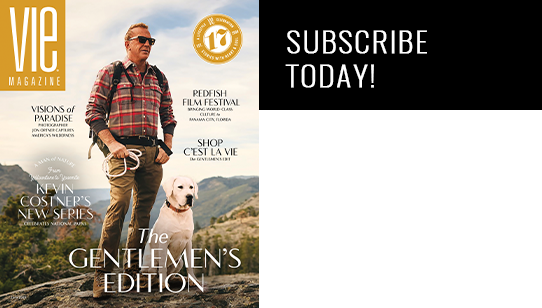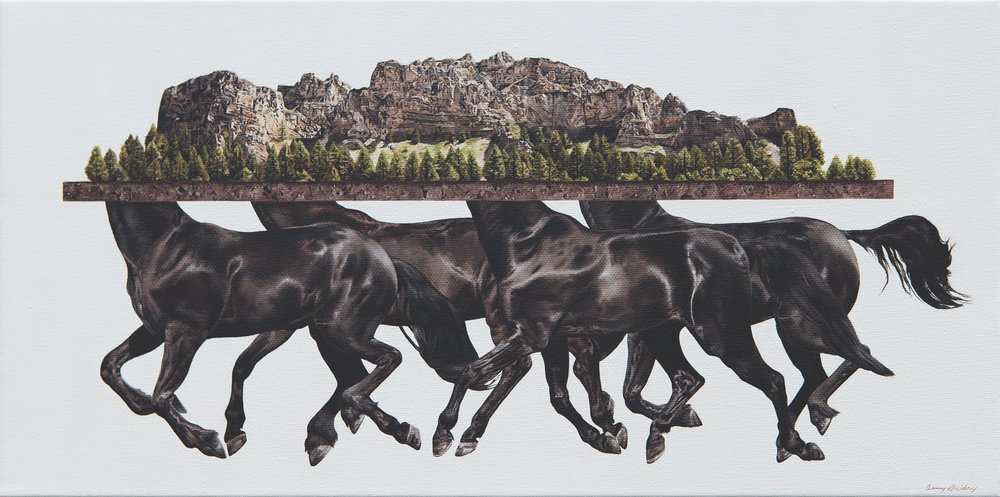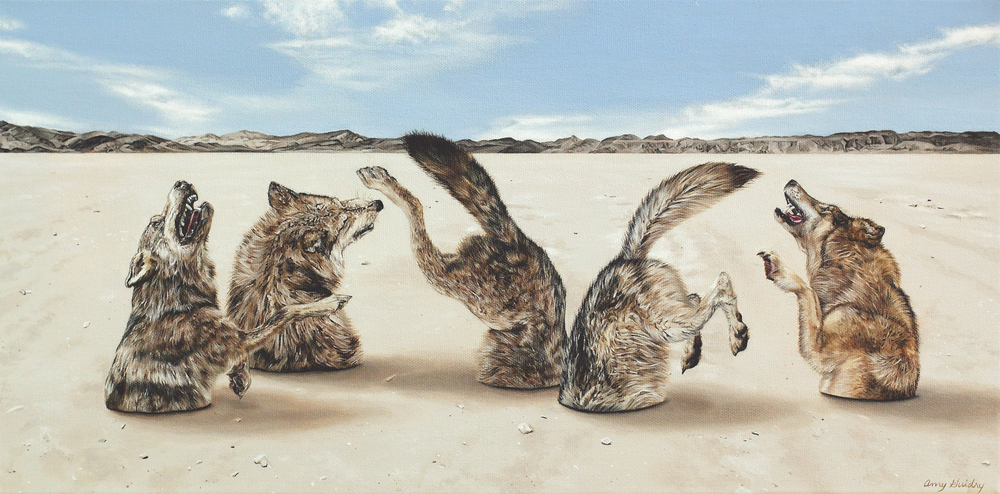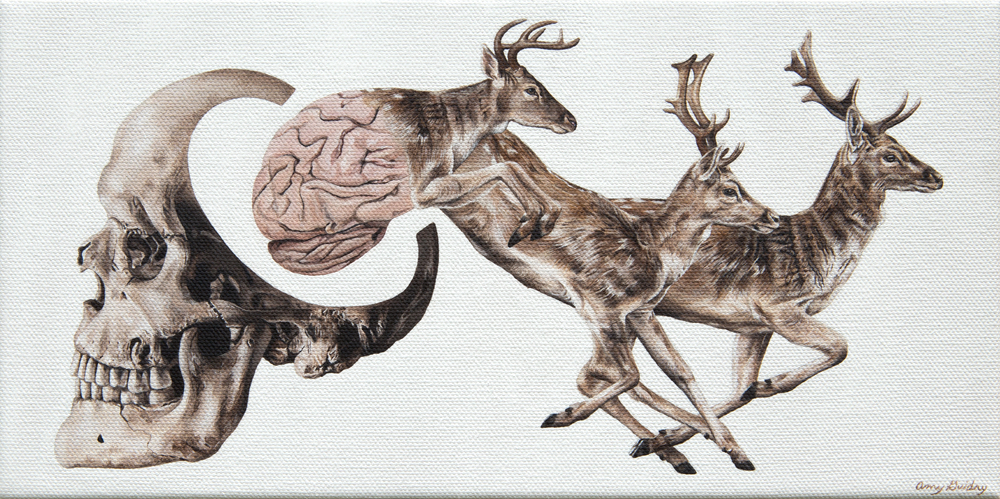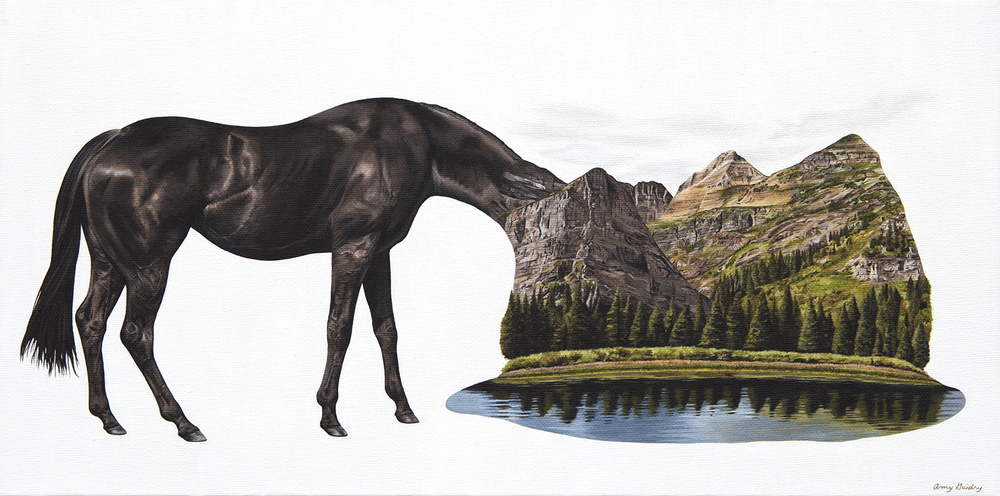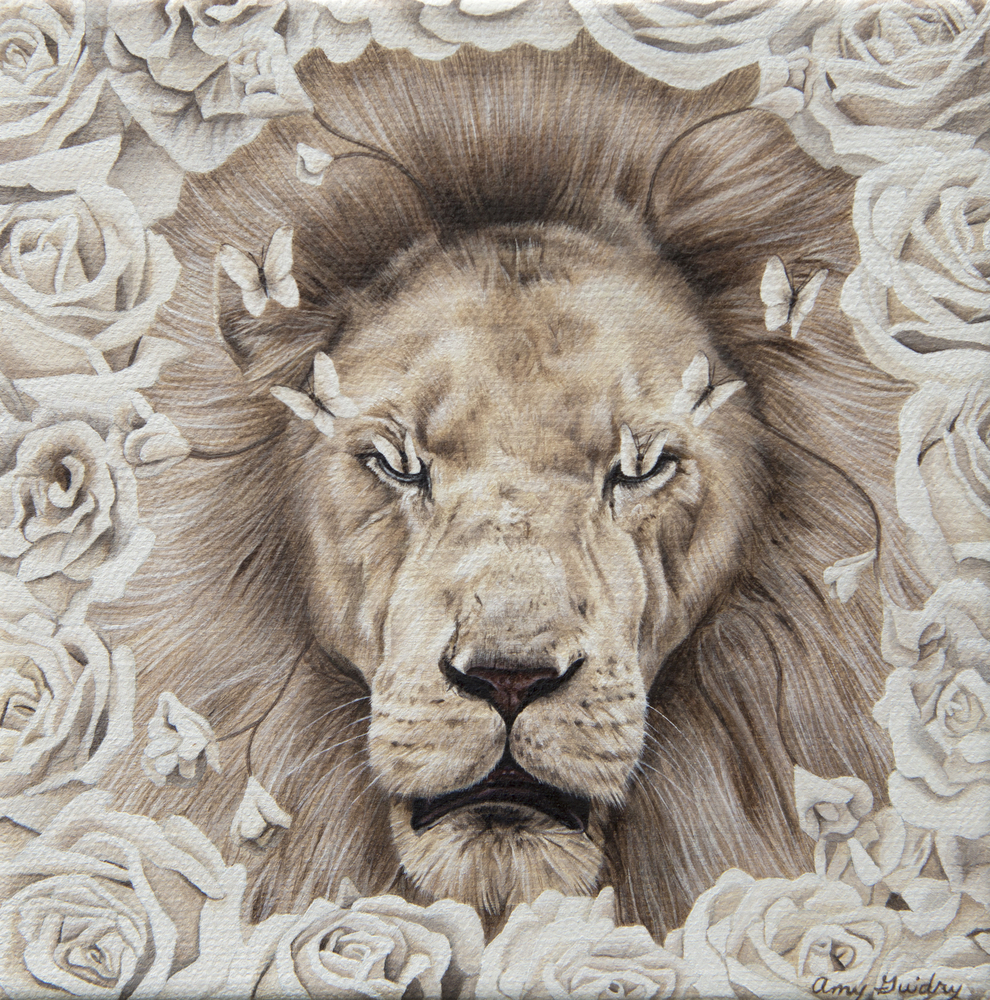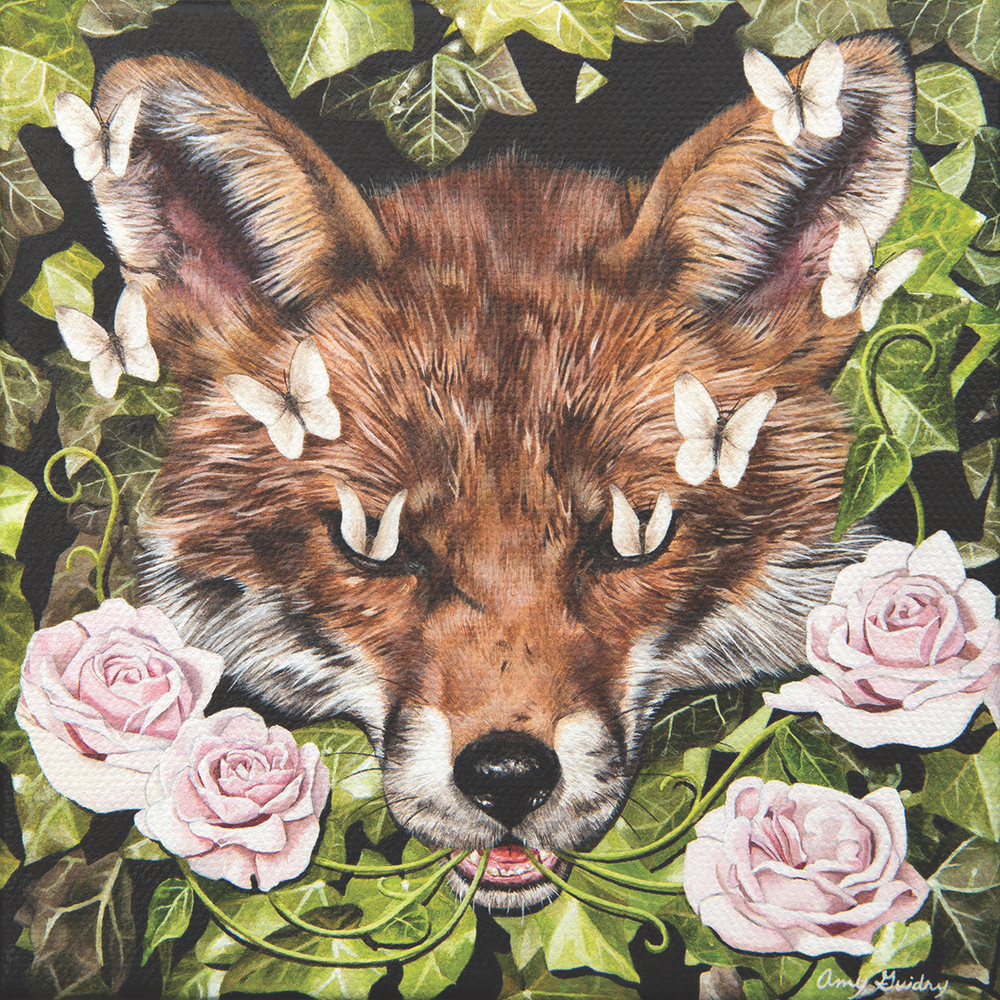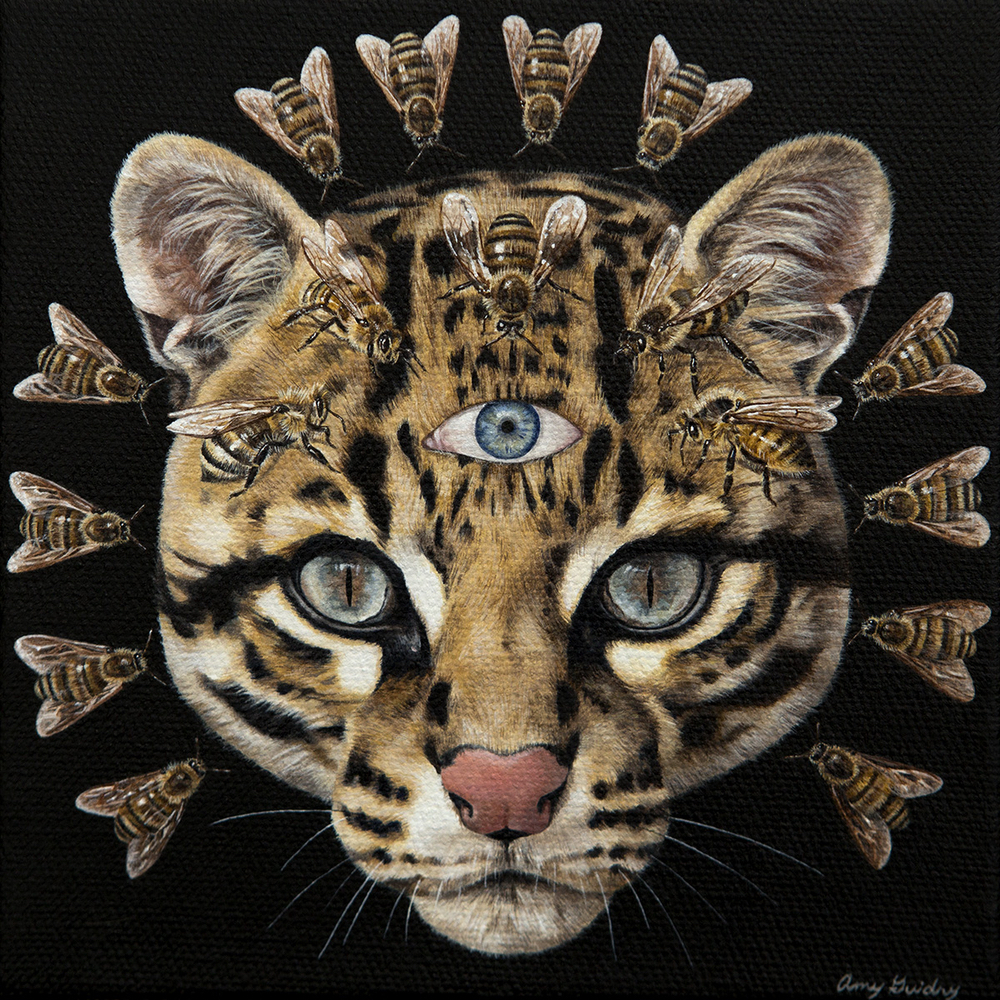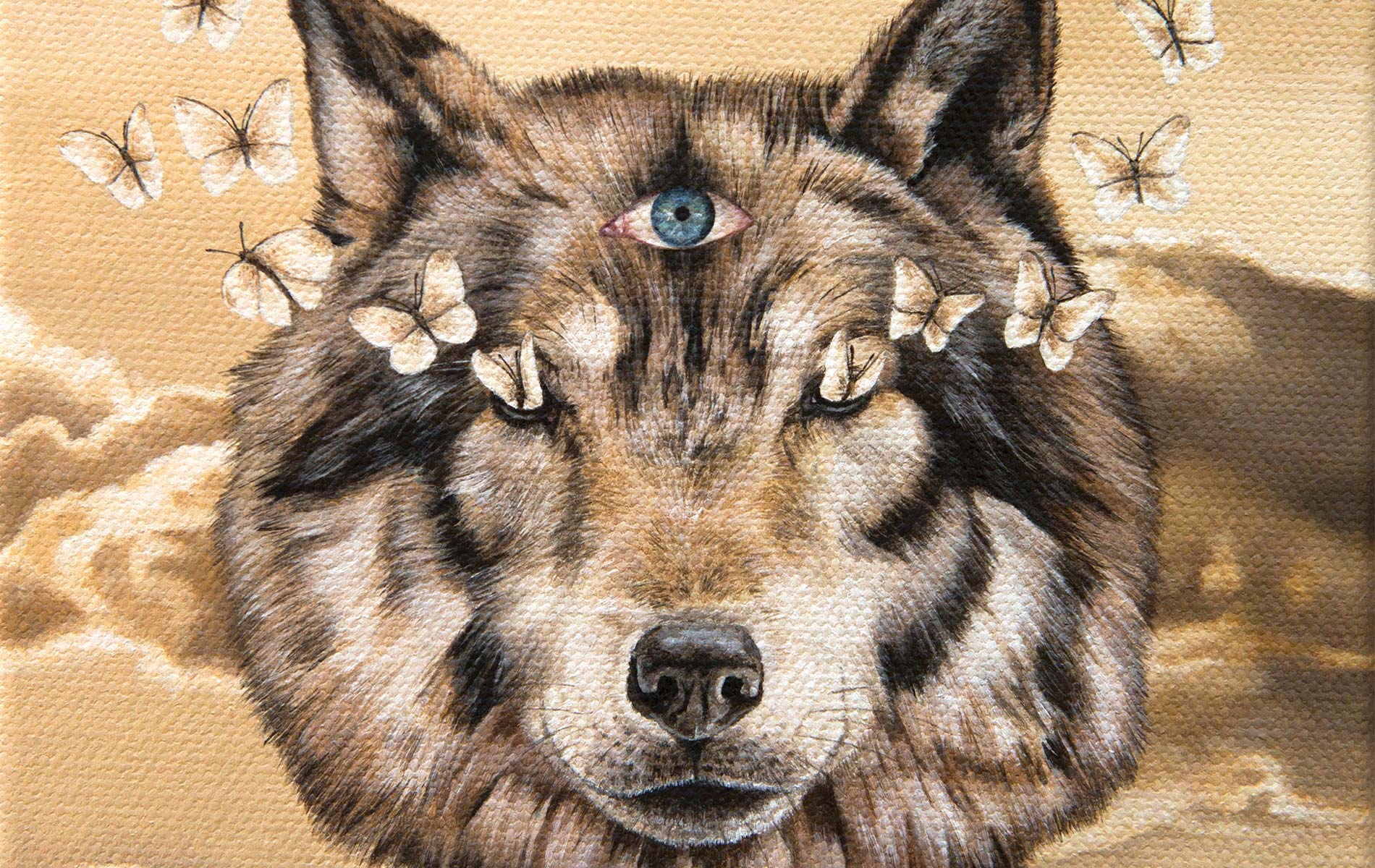
vie-magazine-amy-guidry-hero
Sentience; acrylic on canvas, 6 × 6 in.
The Nature Within
Amy Guidry Gets Surreal
By Sallie W. Boyles | Artwork by Amy Guidry
Artist Salvador Dalí, a surrealism pioneer of the last century, toyed with his critics and admirers upon saying, “The secret of my influence has always been that it remained secret.” Regardless of what stirred his soul, Dalí captivated artist Amy Guidry with his technique. Their attitudes, however, differ in that Guidry enthusiastically explains her motivations and uses her gift and love of painting to ignite change.
With several artists in her family tree, including Eleanor Norcross (1854–1923), a fifth cousin, Guidry acknowledges an innate talent that landed her Loyola University’s most prestigious art scholarship. She graduated with a bachelor’s degree in visual arts and initially worked as a graphic artist and jewelry designer before taking the advice of her husband, Zachary, and launching her fine art career in 2003. Subsequently shifting from commissioned portraiture to producing her inspired collections, Guidry has vividly depicted what occupies her mind and penetrates her soul: the human condition relative to the natural world. “When I first started out,” she says, “I thought I needed to paint what other people wanted me to paint. I’ve discovered over time that I must be excited about the work because it’ll show.” Her paintings have since been exhibited nationwide and received international exposure, garnering collectors from several countries.
Guidry’s mesmerizing imagery can be disquieting for some viewers; however, even when presenting a harsh reality, the artist says, “I want people to understand that I have a positive outlook.” Mentioning her concern for the environment as an example, she says, “We are perfectly capable of preserving nature. With technology, it’s evident that we can create positive results. It’s not all doom and gloom. I want people to remember that.”
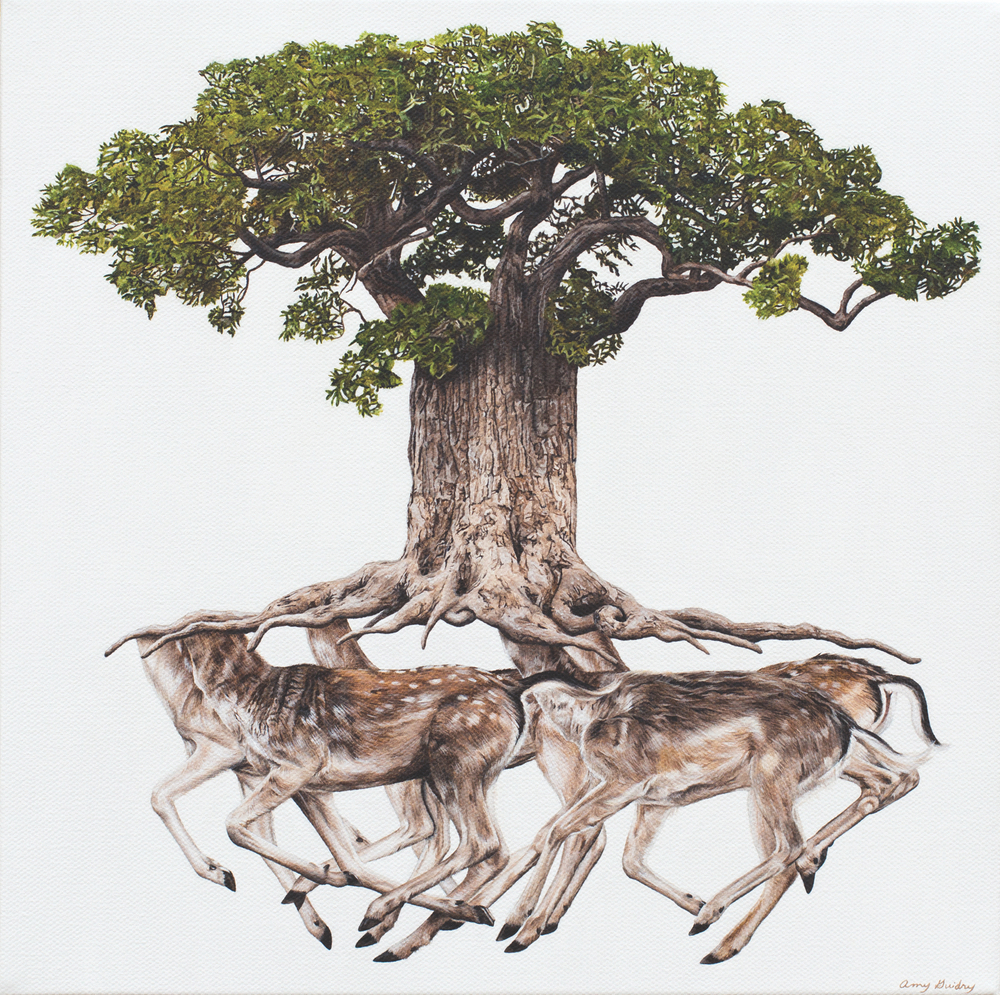
Sustain; acrylic on canvas, 12 × 12 in.
All the same, the artist neither expects nor wants everyone to view her work the same way. “People will have different interpretations based on something personal to them,” she states. Learning what others see and experience also broadens her perspectives. “I like it when they point out some bit of symbolism that I didn’t consider,” Guidry says. Whether they tell her directly or she overhears remarks during an exhibit, she finds it “amazing to know how my pieces perfectly illustrate” a narrative from their lives. “Even if their stories are not my own,” she offers, “I can still relate to them somehow. It’s almost as if we have a subconscious connection.”
“Even if their stories are not my own,” she offers, “I can still relate to them somehow. It’s almost as if we have a subconscious connection.”
She has produced three collections: New Realm, Beneath the Surface, and In Our Veins. The New Realm series endeavors “to challenge antiquated views of women as often seen in fairy tales . . . and explores strength of character and independence.” To execute the theme of each contemplative self-portrait, Guidry incorporates butterflies and birds, symbolizing independence and freedom, along with other animals and natural elements.
In comparison, Beneath the Surface examines “the human experience as a whole—who we are and the interactions and experiences we have in our environment.” Each composition raises unsettling truths about the unnatural, destructive norms of modern culture.
- Integral; acrylic on canvas, 20 × 10 in.
- The Pack; acrylic on canvas, 20 × 10 in.
- Consciousness; acrylic on canvas, 12 in. w x 6 in.
- Indispensable; acrylic on canvas, 20 in. x 10 in.
In Our Veins, Guidry’s current and most prolific series, “explores the connections between all life forms and the cycle of life through a surreal, psychologically charged narrative.” Not yet compelled to move on, she says, “When dealing with animals and nature, I feel that I have so much to cover. There are so many subsets to nature and ecology and saving the environment. I don’t see an end in sight.”
“More than art, I care about animals and nature.” Some of her earliest memories are of spending endless hours exploring the forest next to her home in Louisiana with her dog Juno, a constant childhood companion.
Providing further insight, Guidry says, “More than art, I care about animals and nature.” Some of her earliest memories are of spending endless hours exploring the forest next to her home in Louisiana with her dog Juno, a constant childhood companion. “I would go out in the woods pretty much every day,” she recalls. Like many children, she was fascinated with tadpoles and minnows, but Guidry, who trained a dragonfly to rest on her finger, formed extraordinary bonds with living creatures. No wonder that as a young artist she had the notion to “create a book with illustrations of every animal in the world. When I made this book, I thought everyone would see the animals and love them as much as I do and want to save them from extinction.” Accordingly, she adopted a vegan lifestyle.
Having drawn animals her entire life, she often captures their features from “muscle memory.” Horses fall within that group. “It’s as if I can draw them with my eyes closed,” Guidry says. “I have a lot of contact with animals in nature,” she adds. Encouraging others to spend time outdoors, she and her husband never grow tired of exploring the wetlands of Louisiana, where they’ve settled. “Hiking makes you stop and look at the world—the little things you take for granted. At first glance, you may not see anything, but then you’ll notice the little newts and salamanders and a plethora of insects. I’ve seen all kinds of larger mammals, too, like deer, possums, and raccoons.”
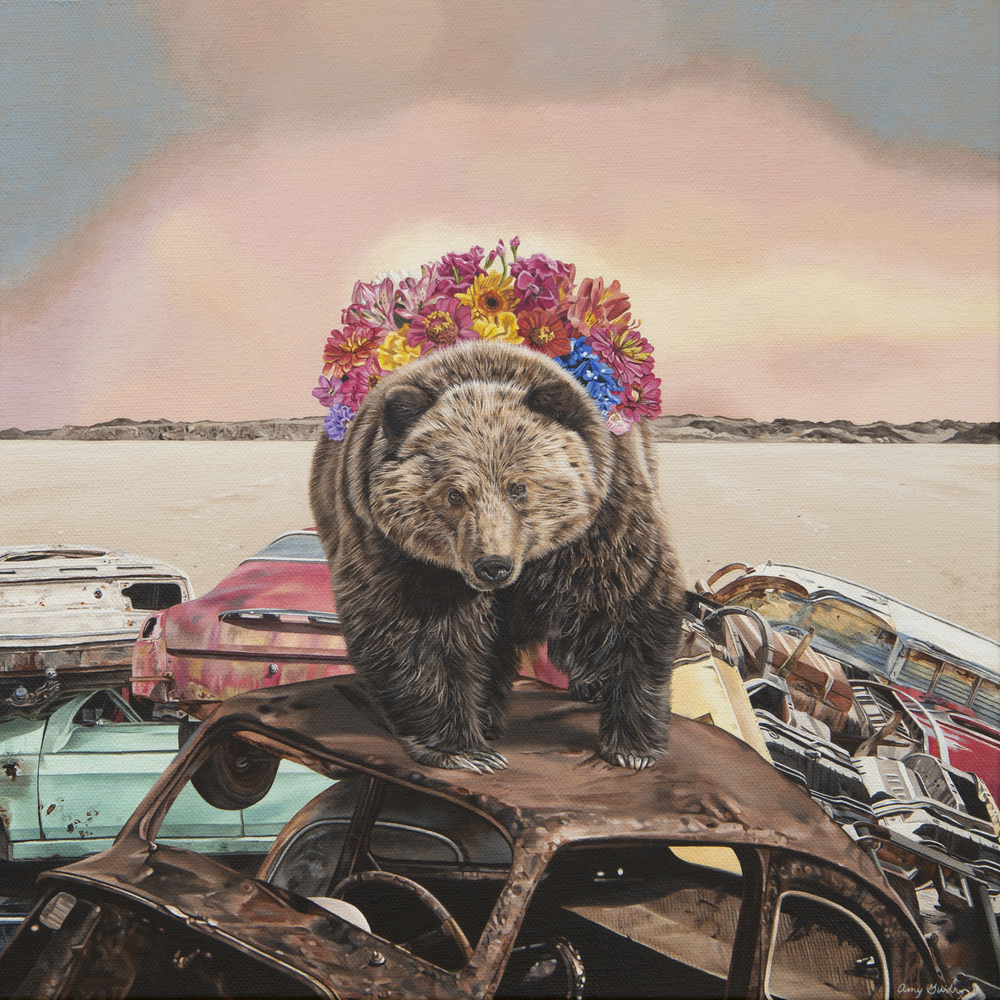
Vestige; acrylic on cavas, 12 in. x 12 in.
Guidry also uses her photography, internet sources, and books with medical illustrations as references. “I do have a skeleton model in my studio,” she reveals. Professors encouraged her to pursue medical illustration when she was in college, but her passion was always painting. That doesn’t mean every step is a breeze; gathering inspiration can be tedious. “Sometimes, I’m just writing things, like facts and figures, and I’ll start brainstorming on the topic,” Guidry says. Many little sketches come next. “For one painting, I might do fifty different thumbnail sketches. It’s very intuitive, so I’ll take one sketch and do multiple variations. It can be painful at times, and if I see that I’m forcing them, I’ll put the work away and take a break. Then, I’ll hit on it, and it’ll be so simple.”
She carefully plans her compositions but says, “Colors can sometimes be a bit of a surprise. I use colored pencils, which gives the gist of it, but I’m coloring quickly, so it’s not a deep application. Once I start painting it out, I may need to tweak something; maybe something needs a splash of red.” Louisiana’s high humidity makes working with acrylics, which dry quickly, the logical option. “My pieces are time-consuming as it is,” Guidry says. “An oil would take a year to dry.”
Her canvases, sometimes as small as four square inches, surprise many upon viewing them in person. People refer to them as “big paintings on a small scale,” which amuses Guidry. She produces larger paintings, too, and for her, it’s always about composition. “Sometimes a small canvas is enough to handle the composition,” she says. Likewise, small size does not mean little time. She’s taken nearly two hundred hours to complete some pieces.
- Transcendental; acrylic on canvas, 6 in. x 6 in.
- Transformation; acrylic on canvas, 6 × 6 in.
- Bestow; acrylic on canvas, 20 x 10 in.
Her commitment to her paintings connects Guidry to each one, but she neither picks favorites, which would be like choosing a favorite child, nor puts any aside for her personal collection. Instead, she acquires original art in different media by others. “I try to distance myself from my artwork at home,” she says. “It’s best because it would be hard to give up a piece. I get attached. I enjoy it while it’s on the easel, and I can continue to enjoy it in a magazine or on my computer.” Relating her paintings to the animals in her life, she says, “There’s a reason why I’ve had so many cats and dogs over the years. They show up, I get attached, and they end up living here!”
Besides, by letting go and sharing her work, Guidry engages those with whom she’d probably never interact in person. They, in turn, can initiate valuable discussions. “I think it’s important for art to have a dialogue that keeps going,” she says. “If I can create a painting that continues that dialogue, it will remind people to do something.”
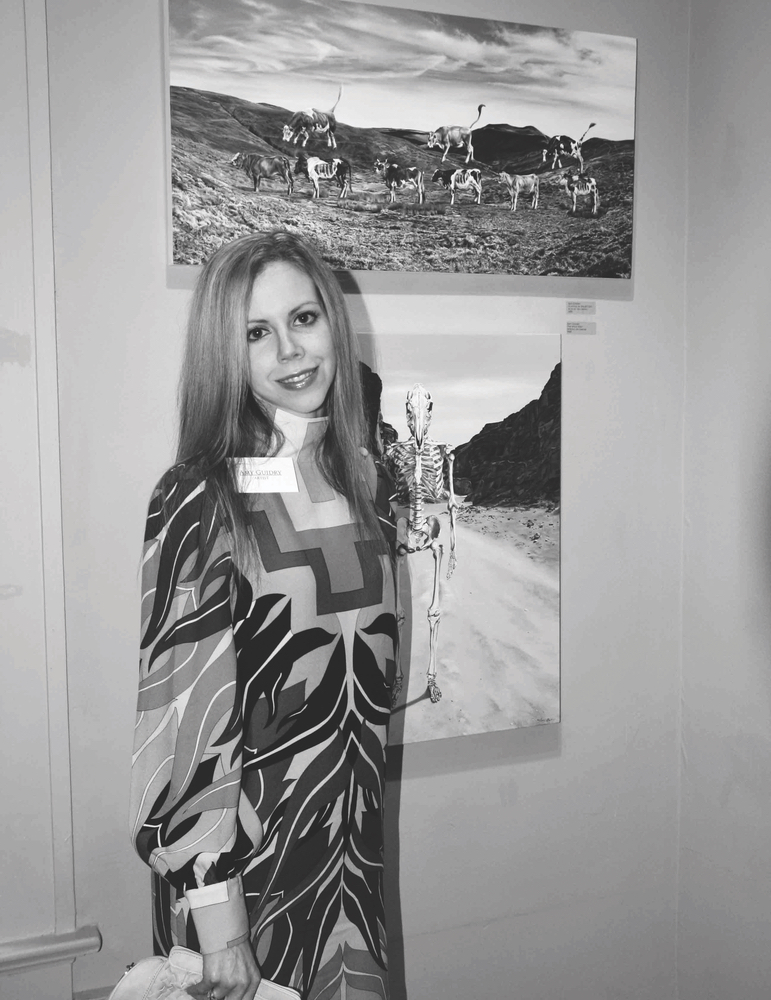
Amy Guidry
— V —
Sallie W. Boyles works as a freelance journalist, ghostwriter, copywriter, and editor through Write Lady Inc., her Atlanta-based company. With an MBA in marketing, she marvels at the power of words, particularly in business and politics, but loves nothing more than relaying extraordinary personal stories that are believable only because they are true.
Share This Story!
KEEP UP WITH THE LATEST STORIES FROM VIE


